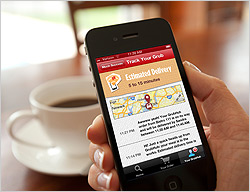Commentary
Seamless and GrubHub Merge To Form A Takeout Powerhouse
- by Steve Smith , Staff Writer @popeyesm, May 21, 2013
 While Yahoo and Tumblr took
all of press oxygen out of the ecosystem yesterday, and the Mogreet/Payvia deal attracted some attention on the margins, a pretty big deal went relatively unnoticed. Two of the more important players
in the online and mobile takeout world have decided to join forces. Seamless and GrubHub have signed a letter of agreement toward a merger.
While Yahoo and Tumblr took
all of press oxygen out of the ecosystem yesterday, and the Mogreet/Payvia deal attracted some attention on the margins, a pretty big deal went relatively unnoticed. Two of the more important players
in the online and mobile takeout world have decided to join forces. Seamless and GrubHub have signed a letter of agreement toward a merger.
Seamless offers ordering for delivery and takeout to more than 12,000 restaurants in the U.S. and in the UK and owns the MenuPages service for providing up-to-date menu content. It has especially strong mobile coverage on all of the major platforms. The even larger GrubHub covers 20,000 restaurants and has its own digital menu brand called Allmenus that boasts 250,000 restaurant menus.
This will create a network of takeout and delivery ordering by Web and mobile for over 500 cities in the U.S. The two companies claim that combined they were responsible for $875 million in gross food sales in local takeout, producing more than $100 million in revenue in 2012.
You would think that mobile ordering is a pretty straightforward affair, but there is room for interesting innovation here. For instance, GrubHub has a cool feature called Track Your Grub. Participating restaurants will send the buyer text messages that give status reports on their order, when it is being processed, and when it is out the door to be delivered or ready to be picked up. Some restaurants are even offering mapping capabilities to track the driver on their way to your door.
Mobile takeout and delivery services will become normalized because in large measure they simply expand the functionality of an activity we already do -- ordering by phone. This simply puts the entire menu in front of us anywhere and any place and spares us having to talk over the din of the restaurant’s background noise while we ask all of our family members what they really wanted to order. This also gives us better access to available deals, just as it gives merchants greater opportunity to push special offers and personalize the experience even further. And this fundamental move of voice phone ordering to data channel phone ordering opens up enormous possibilities for local mobile marketing and advertising.
When it comes to talking about mobile commerce and mobile payments, it’s these incremental mobile extensions of activities to which we are already accustomed that will lead the way. We'll be waiting for years for those point-of-sale systems at some of the major retailers to be able to take a mobile payment. Some of the mom-and-pop local restaurants may already be ready.



